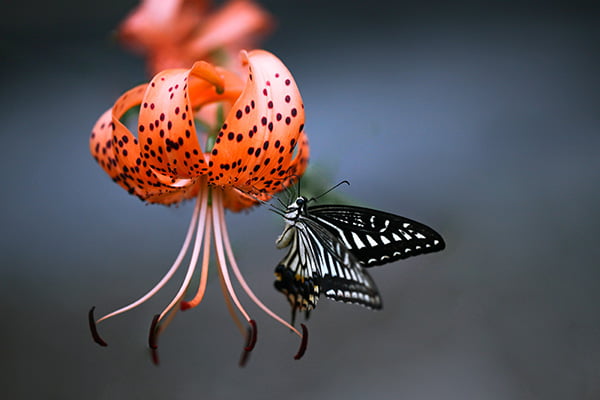Experience the vibrant beauty of the orange tiger lily flowers during the warm summer months! These stunning orange blossoms can be spotted gracing the sides of roads and lining garden borders. Don't let the reputation of lilies being difficult to cultivate deter you, as the tiger lily species is a true survivor. Resistant to diseases and capable of enduring periods of drought once matured, these lilies thrive and propagate quickly through their bulbs.
If you want to add a splash of color to your life (or landscaping), consider planting some of these orange tiger lilies! Below, we'll help you get your tiger lilies planted and tell you everything you need to know to help them burst into bloom.
Botanical Name
Common Name
Plant Type
Mature Size
Sun Requirement
Soil Type
Hardiness Zone
Pet Friendly
Lilium lancifolium
Tiger lily
Perennial
3–5 ft. tall, 7–8 in. wide
Full, partial
Loamy, moist, well-draining
3–9 (USDA)
No
What Are Tiger Lilies?
The Tiger lily flower (Lilium lancifolium and Lilium tigrinum) is a unique Asian species of lily that has spread prolifically in the United States. It grows perennially from bulbs and naturally spreads through bulb division. This type of lily can grow 3 to 5 feet tall, with skinny leaves and stunning flowers, and they are a little shorter than oriental lilies. Each plant will only bloom once per year, but the stalk will be covered with as many as ten flowers!
Typically, the tiger lily flower is orange and speckled with dark spots. The flowers are not always orange, however. Tiger lilies are also found in red and yellow colors. The petals of the tiger lily flower curve back sharply. The dark spots and petal shape are the most tell-tale signs of a tiger lily because those two characteristics are never found together on any other lily species.
How To Plant Tiger Lilies
To grow tiger lilies, you'll need to plant tiger lily bulbs. These can either be planted in the fall as the plants head into dormancy or in the spring once the frosts have passed. Plant each bulb, with the pointed end up and the roots down, about an inch deep into the soil. Keep the soil moist while the bulb is getting established, but never allow standing water to settle. The bulb will focus on forming roots during the first year, and you will notice foliage and flowers the following spring.
Tiger Lily Care Requirements
Light
It's best to grow tiger lily plants in sunny locations that receive at least six hours of direct sunlight daily. However, you don't need to be too particular about this.
While tiger lilies can tolerate some shade, they tend to produce fewer blooms and have weaker stems in shadier locations. Compared to other types of lilies, tiger lilies can tolerate partial shade. However, they tend to produce fewer blooms and have weaker stems in shadier locations. For optimal growth and blooming, it's recommended to plant tiger lilies in an area that receives full sun or partial shade.
If you're planting tiger lilies in a location that gets hot in the afternoon sun, it's important to make sure the soil stays moist to avoid drying out the plant. To retain moisture in the soil, consider adding a layer of mulch around the base of the tiger lily plant.
Water
Tiger lilies are moderately drought-tolerant but bloom best if they receive consistent water. Depending on your climate, regular rainfall will provide the appropriate moisture. If your climate is more arid, you will likely need to water your tiger lilies on a regular basis.
Tiger lily flowers typically thrive in moist, well-draining soil that is consistently moist but not overly saturated. During the summer months, when temperatures are higher, and rainfall may be scarce, you may need to water your tiger lilies more frequently.
To determine if your tiger lily needs water, stick your finger about an inch into the soil near the plant. If the soil feels dry at that depth, it's time to water. While watering, make sure to saturate the soil around the plant's base instead of watering the leaves or flowers.
Temperature And Hardiness Zones
In USDA Hardiness Zones 3 through 9, tiger lily will grow perennially. You will see them begin to grow in spring after the last frost date, bloom prolifically through mid-summer, and go dormant in the fall and winter. In zones where the climate is colder will likely need to dig up the bulbs when the bloom time finishes in late summer. Zones with a particularly intense summer heat should still be able to grow tiger lilies well, as long as the bulbs are planted deep enough in the soil to remain cool.

Source: Unsplash
Humidity
Provided that the soil moisture is correct and consistent, tiger lily will grow in both humid and dry climates. Tiger lily plants can tolerate a range of humidity levels. While they don't require high humidity to thrive, they do prefer moderate humidity levels to grow and flower properly.
Soil
Tiger lily bulbs must be planted in well-drained, slightly acidic soil. They prefer slightly acidic soil with a pH between 5.5 and 6.5. Tiger lilies also prefer soil that is loose and not compacted. If the soil is too compacted, it can make it difficult for the plant's roots to grow and absorb nutrients.
Tiger lilies are hardy and resistant to most plant diseases, but soggy soil can cause problems. You will likely need to amend the standard soil in your garden bed. Adding compost, humus, or other organic matter to the soil when planting the bulbs will give them a nutrient-rich head start. Peat moss, sand, and straw mixed into the soil are also useful to ensure proper drainage. This will help improve the soil structure, increase the soil's water-holding capacity, and provide the plant with essential nutrients.
Fertilization
The tiger lily plant doesn't have many fertilizer needs. Working a layer of compost around the base of the plants each year in the spring will be enough - and this will benefit all of your plants, not just Asiatic lilies! It is also a good idea to spread mulch in late spring, keeping the roots cool during the summer heat. If you'd like to boost your growing tiger lilies, apply a potassium-rich fertilizer when the tiger lily flowers are just starting to develop.
Overwintering
Tiger lilies are hardy plants that survive cold winter temperatures and snow. However, it's important to take a few steps to ensure that they overwinter successfully and come back strong in the spring.
One of the most important things you can do to help your tiger lilies overwinters is to cut back the foliage after the first frost. This will help prevent the plant from using up unnecessary energy and nutrients during the winter months. It's also important to ensure the soil around the plant is well-draining to prevent the bulbs from rotting. Insulating the soil and regulating temperature can be achieved by adding a layer of mulch around the tiger lily plant's base.
Pruning
The tiger lily flowers one time each year, but the stalk is filled with up to ten blooms. You can clip away the spent blooms as they start to fade. In late summer and early fall, the leaves on the lower part of the stalks begin to yellow. Once all leaves have yellowed in late fall, prune the stalks down to ground level.
Propagation
Tiger lilies grow through bulbs that spread and divide each year naturally, causing the lilies to form clumps. To propagate these lilies, you simply need to dig up and divide these bulbs. This is best done in very early spring or in the fall in warmer climates once the stalks have faded.
When the plant is dormant, carefully remove the bulbs from the soil.
Gently separate the bulbs from each other. You can separate individual bulbs or remove the bulbs. Bulbils form along the stem of the plant at the leaf axils. Propagating bulbils will require an extra year of growth before blooming, but it keeps the parent plant from spreading uncontrollably.
Replant the bulbs with the pointed side of the bulb aimed upward.

Source: Pexels
Common Problems When Growing Tiger Lily Flowers
Tiger lilies are a hardy type of lily and aren't prone to plant diseases. However, although they won't show symptoms themselves, they can harbor viruses that can harm other lilies nearby. The lily mosaic virus, for example, distorts the leaves of infected lilies and can eventually kill the plant.
Pests
The only pests that bother tiger lilies are aphids and lily leaf beetles. Both of these pests feed on the sap that is round in the stalk and leaves of the tiger lily. When you notice these insects on your plant, remove as many as possible - by hand or by spraying the lily with a hose. Then, treat the plant with neem oil or insecticidal soap.
Yellow Leaves
If you notice the leaves of your tiger lily turning yellow before fall, this is a sign of poor drainage or overwatering. Simply allow the top inches of the soil to dry out. If you don't see improvement, consider digging up your tiger lily bulbs and amending the soil to improve drainage.
Diseases
Tiger lilies can be affected by fungal diseases such as Botrytis blight, which can cause brown spots on the leaves and flowers. To prevent fungal diseases, it's important to ensure good air circulation around the plant and to avoid overwatering.
Lack of blooms
If your tiger lily is not producing blooms, it may be due to insufficient sunlight or overcrowding. Make sure the plant is receiving enough direct sunlight and that it is not competing with other plants for nutrients and space.
Bulb rot
If the soil around the plant is too wet or poorly drained, the bulbs of the tiger lily can rot. To prevent bulb rot, avoiding overwatering and ensuring the soil has adequate drainage is important.
Are Tiger Lilies Pet Friendly?
Tiger lilies are not considered pet-friendly, especially for cats. All parts of the plant, including the leaves, stems, flowers, and bulbs, contain toxins that can be harmful to cats if ingested. Ingestion of tiger lilies can cause vomiting, loss of appetite, lethargy, and even kidney failure in severe cases. Therefore, it's best to keep tiger lilies out of reach of pets, especially cats, and to seek veterinary care immediately if you suspect your pet has ingested any part of the plant.
